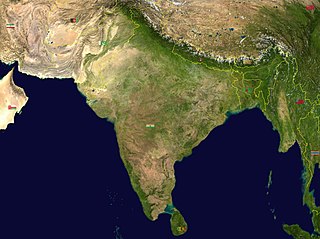
India is situated north of the equator between 8°4' north to 37°6' north latitude and 68°7' east to 97°25' east longitude. It is the seventh-largest country in the world, with a total area of 3,287,263 square kilometres (1,269,219 sq mi). India measures 3,214 km (1,997 mi) from north to south and 2,933 km (1,822 mi) from east to west. It has a land frontier of 15,200 km (9,445 mi) and a coastline of 7,516.6 km (4,671 mi).

Kashmir is the northernmost geographical region of the Indian subcontinent. Until the mid-19th century, the term "Kashmir" denoted only the Kashmir Valley between the Great Himalayas and the Pir Panjal Range. Today, the term encompasses a larger area that includes the Indian-administered territories of Jammu and Kashmir and Ladakh, the Pakistani-administered territories of Azad Kashmir and Gilgit-Baltistan, and the Chinese-administered territories of Aksai Chin and the Trans-Karakoram Tract.

Punjab is a geopolitical, cultural, and historical region in South Asia, specifically in the northern part of the Indian subcontinent, comprising areas of eastern Pakistan and northern India. The boundaries of the region are ill-defined and focus on historical accounts.
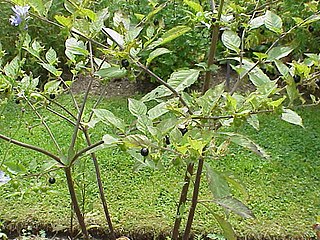
Atropa is a genus of flowering plants in the nightshade family, Solanaceae: tall, calcicole, herbaceous perennials, bearing large leaves and glossy berries particularly dangerous to children, due to their combination of an attractive, cherry-like appearance with a high toxicity. Atropa species favour temperate climates and alkaline soils, often growing in light shade in woodland environments associated with limestone hills and mountains. Their seeds can remain viable in the soil for long periods, germinating when the soil of sites in which plants once grew is disturbed by human activity or by natural causes, e.g. the windthrow of trees. The best-known member of the genus Atropa is deadly nightshade - the poisonous plant par excellence in the minds of many. The pharmacologically active ingredients of Atropa species include atropine, scopolamine, and hyoscyamine, all tropane alkaloids having anticholinergic, deliriant, antispasmodic and mydriatic properties. The genus is named for Άτροπος (Atropos) - lit. 'she who may not be turned (aside)' - one of the Three Fates and cutter of the thread of life / bringer of death - in reference to the extreme toxicity of A.belladonna and its fellow species - of which three others are currently accepted.

Atropa belladonna, commonly known as belladonna or deadly nightshade, is a toxic perennial herbaceous plant in the nightshade family Solanaceae, which also includes tomatoes, potatoes, and eggplant (aubergine). It is native to Europe, North Africa, and Western Asia. Its distribution extends from Great Britain in the west to western Ukraine and the Iranian province of Gilan in the east. It is also naturalised or introduced in some parts of Canada and the United States.
1999 in the Republic of India.
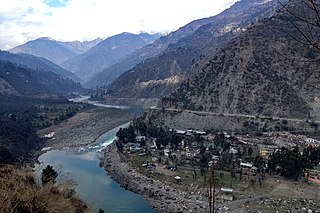
The Chenab River is a major river that flows in India and Pakistan, and is one of the 5 major rivers of the Punjab region. It is formed by the union of two headwaters, Chandra and Bhaga, which rise in the upper Himalayas in the Lahaul and Spiti district of Himachal Pradesh state, India. Chenab flows through the Jammu region of Jammu and Kashmir, India into the plains of Punjab, Pakistan, before flowing into the Indus River near the city of Uch Sharif.

North India is a loosely defined region consisting of the northern part of India. The dominant geographical features of North India are the Indus-Gangetic Plain and the Himalayas, which demarcate the region from the Tibetan Plateau and Central Asia.

Scopolia is a genus of four species of flowering plants in the family Solanaceae, native to Europe and Asia. The genus is named after Giovanni Scopoli (1723–88), a Tyrolean naturalist. The genus has a disjunct distribution, with two recognised species in Central to Eastern Europe,, and two species in East Asia. The two European species are:
The Indus Waters Treaty (IWT) is a water-distribution treaty between India and Pakistan, brokered by the World Bank, to use the water available in the Indus River and its tributaries. It was signed in Karachi on 19 September 1960 by Indian Prime Minister Jawaharlal Nehru and Pakistani President Ayub Khan.
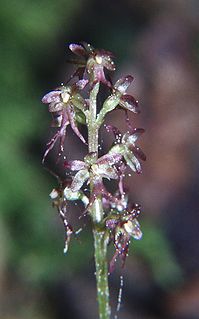
Neottia is a genus of orchids. The genus now includes the former genus Listera, commonly known as twayblades referring to the single pair of opposite leaves at the base of the flowering stem. The genus is native to temperate, subarctic and arctic regions across most of Europe, northern Asia, and North America, with a few species extending into subtropical regions in the Mediterranean, Indochina, the southeastern United States, etc.
Nepeta discolor is a low-growing species of catnip that is commonly found in the alpine (Himalayas) and temperate regions of Xizang (Tibet) in China; Garhwal division, Himachal Pradesh, Jammu, Uttar Pradesh in India; Afghanistan; Pakistan; and Nepal. The species is named after the color of the leaves. It was described in 1833.
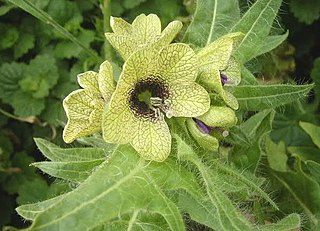
Hyoscyameae is an Old World tribe of the subfamily Solanoideae of the flowering plant family Solanaceae. It comprises eight genera: Anisodus, Archihyoscyamus, Atropa, Atropanthe, Hyoscyamus, Physochlaina, Przewalskia and Scopolia. The genera Archihyoscyamus, Atropanthe and Przewalskia are monotypic, the first being endemic to Turkey and Iran, the second to China and the third to Tibet.
Secession in India typically refers to state secession, which is the withdrawal of one or more states from the Republic of India. Whereas, some have wanted a separate state, union territory or an autonomous administrative division within India. Many separatist movements exist with thousands of members, however, some have low local support and high voter participation in democratic elections.

Sinopodophyllum is an herbaceous perennial plant in the family Berberidaceae, described as a genus in 1979. It includes only one known species, Sinopodophyllum hexandrum, native to Afghanistan, Bhutan, northern India, Kashmir, Nepal, Pakistan, and western China. Common names include Himalayan may apple and Indian may apple.
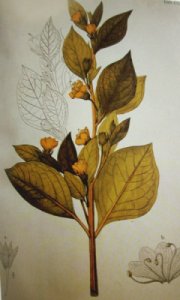
Atropa baetica is one of Europe's rarest wildflowers. A close relative of the infamous deadly nightshade its specific name derives from that of the Roman province of Hispania Baetica, while its common name refers to the Spanish region of Andalucía – both designating the area in the south of Spain where it is most frequently encountered. It is an attractive, perennial herbaceous plant bearing infundibuliform, yellow or greenish flowers and shiny, black berries. Like the other three species of Atropa, it is an extremely poisonous plant, containing a variety of tropane alkaloids with anticholinergic, deliriant, antispasmodic and mydriatic properties. Although most populations of the plant are to be found in Spain, it is not wholly confined to the Iberian Peninsula of Europe, occurring also in certain localities in Morocco and Algeria in the Atlas Mountains of North Africa. The Rif and the Baetic System, which face each other across the Alboran Sea, together constitute one of the finest of the Mediterranean biodiversity hotspots – rich in endemic species, of which Atropa baetica is a notable example..
Atropa pallidiflora is a close relative of the infamous deadly nightshade and, like it, is an extremely poisonous plant, containing a variety of tropane alkaloids valued in medicine for their anticholinergic, antispasmodic and mydriatic properties and deliriant in excess. Atropa pallidiflora is the least well-known of the four currently accepted species of Atropa and is endemic to the remarkable Caspian Hyrcanian mixed forests of Northern Iran, which can boast all the species of Atropa currently recognised, with the sole exception of the strictly Ibero-Maghrebi A.baetica. The binomial Atropa pallidiflora was published by Eva Schönbeck-Temesy in volume 100 ('Solanaceae') of Karl Heinz Rechinger's monumental Flora Iranica in 1972. The specific name pallidiflora signifies 'bearing flowers of a pale, wan or washed-out hue' and, while appropriate, is not especially evocative, given that the flowers of most Atropa species are far from vivid. The flowers of A. pallidiflora, like those of A.baetica, vary from greenish to yellow, but, as the designation 'having pallid flowers' might suggest, the yellow in question is a dingy greenish-yellow that is far from ornamental. The geographical term 'Hyrcanian' in the common name signifies that the plant is native to what was once the satrapy of Hyrcania, the name of which derives from an Iranian root meaning 'wolf' : Hyrcania is thus the 'Land of Wolves'. The name is an apt one, since the Hyrcanian forests have long been known as a hunting ground of legendary richness and beauty : the lush forests could support an abundance of large, mammalian herbivores, which in turn could support an abundance of apex predators - notably the wolf, but also the Persian leopard and even the tiger. The word 'Hyrcanian' will be familiar to any diligent reader of the works of William Shakespeare, as an epithet of the proverbially savage Caspian Tiger, known to the dramatist from his reading of the works of various Latin authors - who, in turn, were familiar with the Ancient Greek coinage 'Hyrcania' and the lands adjoining the Caspian Sea to which the place name referred. Regarding the richness of the Hyrcanian flora - of which Atropa pallidiflora is a noteworthy element - it is worth mentioning that the name of the modern Iranian province of Golestan has the delightful meanings of 'Rose Garden' and 'Land of Flowers'.

Jammu and Kashmir is a region administered by India as a union territory and consisting of the southern portion of the larger Kashmir region, which has been the subject of a dispute between India and Pakistan since 1947, and between India and China since 1962. The Line of Control separates Jammu and Kashmir from the Pakistani-administered territories of Azad Kashmir and Gilgit-Baltistan in the west and north. It lies to the north of the Indian states of Himachal Pradesh and Punjab and to the west of Ladakh, which is also subject to the dispute as a part of Kashmir, and administered by India as a union territory.
Pauia is a monotypic genus of flowering plants belonging to the family Solanaceae. It only contains one known species, Pauia belladonnaDeb & Ratna Dutta











